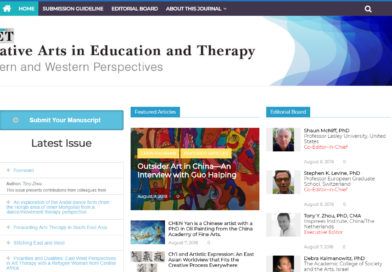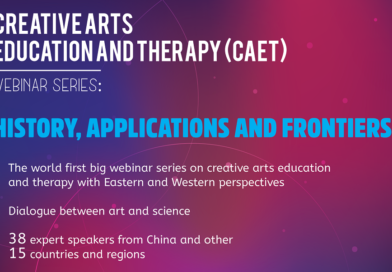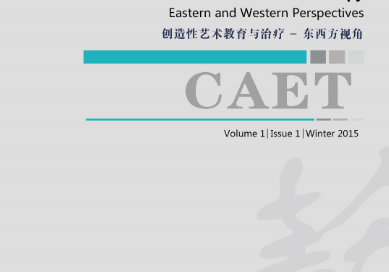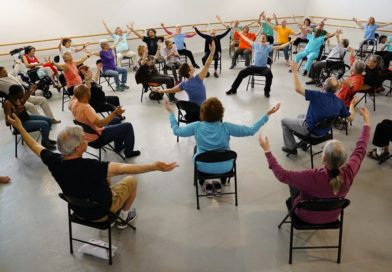Current Issue
“Art Meets Books”: A Co-produced Arts Pilot Project in Public Libraries
Author: Val Huet
The “Art Meets Books” (AMB) pilot project is an innovative partnership involving a charity, Paintings in Hospitals, an art therapist (the present author), and public libraries. AMB delivers arts workshops within public libraries in economically deprived areas in London and the West Midlands and engages people who do not usually access art resources. Through outreach work within Further Education colleges, AMB also engages ethnically diverse participants. AMB integrates a co-production ethos and art-based reflexive practice. An evaluation conducted throughout the project showed that participants (N=49) reported positive experiences of the project. The evaluation identified issues to integrate into the project’s future delivery. Read more
The Exploration of Music Therapy Professional Competency in Chinese Higher Education
Author: Sisi Lin, Lo-Ting Chen
Competency is the core of vocational and professional training. Under the current situation in the development of music therapy higher education in China, this article analyzes the core characteristics and practical application of the competency-based education (CBE) model and puts forward reflections on the development and implementation of the CBE model in music therapy higher education in China. It is suggested that the music therapy professional competencies in Chinese higher education need multidimensional cooperation and mutual concern among colleges and universities, professional associations, and the job market, and the effect of “professional competencies” on the music therapy profession in China and their contribution to professionalization should be discussed. Read more
The Enactive Nature of the Relationship between Criticism and Aesthetics: From Practice to Theory to Pedagogy
Author: Ivan Magrin-Chagnolleau
This article delves into the intricate relationship between criticism and aesthetics, emphasizing its enactive nature. It explores how this relationship informs pedagogy and has culminated in the creation of an innovative undergraduate aesthetics course centered around the practice of writing critiques. Moreover, it illustrates the dynamic process through which practice gives rise to theory, subsequently influencing pedagogical approaches, and, intriguingly, circling back to practice. To elucidate this flow of ideas across the realms of practice, theory, and pedagogy, we introduce several key concepts. These include the paradigm of creation research, also known as practice as research, which forms the foundation for much of our exploration. Additionally, we delve into the paradigm of enaction, inspired by the work of Francisco Varela in the cognitive sciences, to shed light on the cognitive processes underpinning our study. This article is the culmination of nearly a decade of interdisciplinary research that traverses the domains of creation research, enaction, phenomenology, criticism, aesthetics, and pedagogy. Throughout this journey, we have sought to unravel the intricate connections between criticism and aesthetics, ultimately paving the way for an innovative approach to teaching aesthetics at the undergraduate level. Read more
Poetry in Peer Groups to Reduce Suicide in a Latin American Context
Authors: Felipe Agudelo-Hernández, Mariana Rojas Echeverry, Matías Mejía Chaves
The objective of this study was to determine the impact on the reduction of mental health problems in adolescents who participate in support groups with poetry, those who participate in groups with other methodologies, and those who do not participate in support groups. This community trial, which performed in 2021, included 1252 adolescents, of whom 171 showed suicidal risk. Three groups were formed: a support group where poetry was included among the methods, a support group that worked on crafts, and a control group that did not participate in support groups. Greater recovery occurred in adolescents who participated in poetry. Recovery strategies can include artistic elements in their methodologies to increase effectiveness. Read more
Change Process Research in Music Therapy: Introducing a Transdisciplinary Framework
Author: Lorenzo Antichi, Rebecca Zarate, Marco Giannini
Music therapy is conceptualized as a systematic process of interventions and shared experiences that promote change in individualized health and wellbeing contexts. Change processes are crucial in music therapy, but little is known about certain factors, mediators, and mechanisms that cause or lead toward such change processes. There is a strong need for developments of theoretical and methodological frameworks of change in music therapy to achieve this goal. The current body of knowledge shows a lack of research on this topic, particularly on how to strategize and study change, how to understand research design and statistical analysis of change, and how to support and strengthen what is known today about change processes in music therapy. This article is grounded in theories that address complex interventions that cause a change in music and creative arts therapies as a means of guiding a dialogue about the potential for influencing research strategies and methods that investigate change processes. The review of the literature shows that although new studies about the efficacy of music therapy have been made in recent years, literature is extremely limited about predictors, moderators, shapes of change, stages of changes, processes, and mechanisms of change. There is strong evidence that music therapy works. However, it is not entirely known how, when, and why music therapy produces a change. Based on the findings in the current body of knowledge, further studies are needed to investigate every aspect of change with a pluralistic and interdisciplinary approach, which integrates methods from across the natural sciences, mathematics, arts, behavioral, and social sciences. This article introduces a framework addressing these issues, attempts to bridge current gaps in knowledge, expand capacity in the field of music therapy research, and equip clinicians, researchers, and professionals with tools and knowledge on change process research. Read more
Studio Art Therapy Learning Ecology: Crossing Borders between Art, Education, Health, and Therapy
Authors: Kathryn Grushka
Studio Art Therapy is a unique learning ecology with border crossings between visual arts therapies and art studio practice, education, and health. The increased fluidity between research and practice spaces, art therapy, and arts health are elaborated as a concept, theorized with the western Deleuzoguattarian philosophy. Connections and differentiations between art making and art as therapy are revealed in a discussion of an empirical research project Art, Visual Narrative, and Wellbeing Project (AVNAW). Studio art therapy focuses on body, meaning, and healing. It speaks to the value of people making art, reflecting and talking about their making processes alone and together through an autoethnographic visual narrative approach to artmaking. The paper asks how studio visual artmaking can activate individual productive desire to adapt toward becoming well through artmaking. Care, community, belonging, and resilience are core to a studio art therapy learning ecology that responds to real-life experiences in the support of personal care and wellbeing. Read more
The Art of Planting Rice as a Meditative Practice: Sensemaking and Equanimity about Societal Disruption through Performance Art
Authors: I Made Jodog, Jem Bendell
The impact of COVID-19 on Bali, Indonesia, decimated a significant part of the economy, resulting in unemployment and underemployment, which increased economic difficulties and related anxiety. Many people returned to small-holder farming to sustain their families. Away from farming, meditation is widely recognized as a means for equanimity and coping better with anxiety. In solidarity with the return to farming in Bali, the lead author of this paper created a performance art experience involving the planting of rice as a meditative practice. This paper summarizes the process and what was learned during the experience, using elements of qualitative research. The analysis affirms the role of artistic expression in supporting people’s sensemaking about societal disruption, with implications for social learning and mental well-being. Read more
Mural Painting and Inclusive Research in Cameroon: Implementation and Impact at the University of Bamenda Campus
Author: Paul Ngong Animbom
This paper describes the use of mural-making as part of the knowledge mobilization activities of an international research partnership project. The mural depicts the technical and academic activities of people with disabilities in a university setting as meaningful action in inclusive research processes. The main objective of this 30-meter mural painting on a wall in the University of Bamenda was to demonstrate that inclusive research could encourage the inclusion and participation of people with disabilities in all areas of academic and professional activities of the university. A mural-making protocol was developed by the faculty and implemented by the team. It included the collection, analysis, and understanding of data on inclusion; design of drawings and the mural; wall preparation; plotting; and execution of the actual mural. The brightly colored mural now draws attention to inclusion, provides a vision of hopefulness, and complements the narrative character of inclusive education and research on campus. Read more
Embracing the Kahankar and the Ahankar: A Reflexive Inquiry into Body, Movement, and Consciousness, Interwoven with the Warli Philosophy
Author: Devika Mehta Kadam
This article aims to deepen the understanding of existential intrasubjectivity and intersubjectivity as they relate to the body, being, and nature, as experienced through the lens of Warli philosophy, particularly the Kahankar and the Ahankar. This reflexive inquiry lies at the intersection of the author’s identity as a researcher, a dance movement therapist, and a spiritual being. The contemplation includes experiencing Nature as a witness, another facet of the Warli conviction of the profound interconnectedness with the natural world, recognizing our inherent composition as part of nature. Another dimension of engaging with this philosophy is through the practice of Authentic Movement, where the imagination, the psyche, and the soul all dance together as they are witnessed nonjudgmentally. I employed an external witness as well as used self-witnessing in the form of an “inner witness.” Lastly, it explores the dance between the body as the storyteller and the consciousness as the affirmer of the spoken word, the truth. Read more
Cultural Appropriateness, Arts-based Care and Well-Being in Sensitive Research
Authors: Ying (Ingrid) Wang
This article explores the nexus of cultural appropriateness, arts-based care, and well-being in sensitive research on sexual violence, with a focus on New Zealand’s Asian community. Drawing on the author’s background as an Asian immigrant arts-based researcher, this study underscores the pivotal role of care, both culturally and through arts-based approaches, in facilitating understanding and expression. Emphasizing the importance of caring for both research participants and the researcher’s own well-being, the article advocates for culturally sensitive practices throughout the research process. It demonstrates how arts-based research methods enable creative expression and deeper cultural comprehension, enhancing care provision for participants. Moreover, the article highlights the need for culturally sensitive self-care strategies for researchers, acknowledging the emotional toll of engaging with sensitive topics. Ultimately, it calls for a more compassionate, culturally attuned, and ethically grounded approach to sensitive research within diverse cultural contexts. Read more
The Lexicon of Pain: Highlighting the Advantages of Applied Theater in Pediatrics through the Lens of Psychodynamic Therapy
Author: Persephone Sextou, Stelios Kiosses
Applied theater for health and well-being suggests itself as an effective tool for social and emotional interaction and communication of emotions, developing creativity, imagination, and regulation of emotions during hospitalization. This paper aims to explore the value of communicating emotions through applied theater and storytelling in pediatrics and its potential in clinical practice in a discussion through the lens of psychodynamic therapy. We will explore the intersections, synergies, and possible collaborations between the theatrical form as a condition for openness and verbalizing pain and therapy as a method of processing and dealing with emotions. We discuss fictional stories told by children during applied theater and storytelling research interventions in hospitals as case studies through the lens of psychodynamic therapy with children. We explore these stories by using interdisciplinary, synthetic, and dialectic analysis between the researcher-artist and the psychodynamic therapist. We ask if the stories that hospitalized children create within theatrical interventions can help adults and clinical staff understand better the children’s lexicon of pain, leading to sensitive healthcare. The rich narrative discussion of the case studies indicates that applied theater in hospitals enhanced well-being support in children and as gateways for improved care. The core themes that emerged include empowerment, synergies and exchanges of emotions, emotional reassurance, and imagination. This analysis of hospitalized children’s stories from a psychodynamic therapist’s point of view has scope for informing alternative, nonmedical activities with children in the hospital and those who would benefit from clinical therapy and the performing arts. Read more
Recent Issues
Call for Submission
CAET Call-for-Submission 2025 Winter. The deadline for the submission is September 1, 2025. The Summer Edition 2025 submission was CLOSED already.
Latest Issue Online
CAET 2024 winter issue (10.2) is online now. See details.
Feature Articles
Editorial Board
News and Events

Launching new website for CAET journal
CAET, one of the flagship products of Inspirees Education Group (IEG), is now an open access journal with the launching

CAET Webinar series: History, Applications & Frontiers
Following the success of our webinar series Laban – History, Applications and Frontiers which was launched in 2017 and has attracted

A warm welcome to CAET editorial board members
CAET is glad to announce its expanding editorial board with a warm welcome to Alexander Kopytin and Ma Liwen. Till

Launching Dance for PD China
Dance for Parkinson’s Disease (DfPD) has been launched by MMDG and Inspirees Institute in China.

